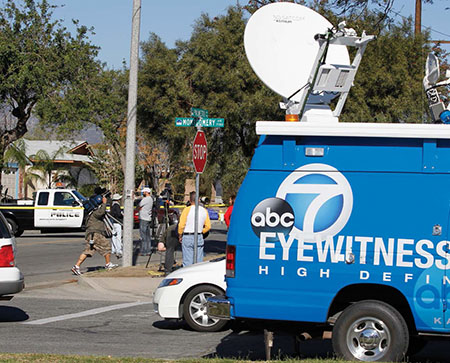Main Studio Rule Change May Bring Cost Savings
WASHINGTON—The FCC’s decision to dump the main studio rule, and eliminate the associated minimum staffing and program origination capability requirements, will likely have broadcasters across the country quickly reviewing their operations for potential cost savings if they haven’t done so already.

Banishment of the main studio rule will present significant savings opportunities for television and radio broadcasters, which could then be pocketed or invested in programming and equipment, industry observers say. The FCC said so itself in its Report and Order: “Eliminating the main studio rule will produce substantial benefits. Broadcasters will be able to redirect the significant costs associated with complying with the main studio rule to programming, equipment upgrades, newsgathering and other services to the benefit of consumers.”
‘UNNECESSARY MAIN STUDIOS’
Industry observers say even though the FCC’s main studio rule typically impacted more radio broadcasters than TV, some television broadcasters believe there will be savings. Nexstar Broadcasting, which owns 160 television stations, submitted comments during the FCC proceeding in support of the move to eliminate the main studio rule. Nexstar said in its comment providing a broadcast service to the public is expensive.
“The cost of the equipment required to distribute broadcast signals, plus a (main studio) building and at least two full-time employees result in expenditures well into and beyond six figures annually between lease and/or structure payments and salary and benefit obligations. The funds expended to maintain unnecessary main studios can be better spent to provide local news, additional local programming or better transmission services.”
Meanwhile, Forum Communications Company, which operates four local broadcast television stations in North Dakota, told the FCC the elimination of the main studio rule would enhance the broadcaster’s “service to the public by allowing certain station personnel to dedicate more time to engage in sales, newsgathering, technical, promotional and other activities during periods of the day that are currently devoted to maintaining the minimum staffing requirements of the main studio rule.”
In addition, small, independent broadcasters like Los Angeles-based Venture Technologies, which owns several Class A television stations, could reap “instant benefit from the rules’ purge, gaining the flexibility to allocate capital toward the acquisition of new, diverse programming or improved equipment,” according to comments the company filed with the commission.
MEDIA OWNERSHIP
While co-locating studios is likely a bigger deal for radio than TV, observers say that could change as the commission loosens multiple ownership restrictions, which could happen as soon at the FCC’s November meeting. For example, the expected elimination of the newspaper cross-ownership prohibition combined with the elimination of the main studio rule may make newspaper/TV deals more feasible.
Get the TV Tech Newsletter
The professional video industry's #1 source for news, trends and product and tech information. Sign up below.
Several broadcast industry observers contacted for this story believe broadcasters will be eager to wring out as much savings as they can through various measures. But they also caution that those who turn away from servicing their local communities could suffer consequences.
Communications attorney Harry Cole at Fletcher, Heald & Hildreth says broadcasters have been keeping a close eye on FCC proceedings since the latest studio requirement rulemaking was proposed back on May 18, 2017. The rule change takes effect once the decision is published in the Federal Register, which is expected to be by early November.
“Since the elimination of the rule has been in the works for some time now, with the ultimate result largely pre-ordained, I would expect that most broadcasters who perceive the opportunity of cost savings have been planning out their moves in advance,” Cole said. “It would not surprise me to see a number of moves in the near-term intended to take advantage of the change. The elimination of the studio requirement will allow consolidation of staff, equipment and operations, and relieve licensees of various costs like rent, insurance, duplicative staffing, equipment, etc. I assume that, at least for some if not many, the savings could be substantial.”
Cole said he believes there will be job losses as a result of broadcaster’s further consolidating operations. “I’m guessing that one of the anticipated sources of cost savings will be in reduction of staff. If I’m right, then the more stations that abandon their main studios, obviously the more jobs are likely to be eliminated. I don’t know how drastic the effect is likely to be.
“However, it does occur to me that wholesale abandonment of any and all local presence in a station’s community could be a short-sighted move,” Cole added. “A crucial aspect of broadcasting’s service that has long distinguished the industry from other media sources is its localism, a quality often touted by broadcast representatives. Moving station operations out of town will very possibly undermine broadcasting’s claimed identity as a local service, which could have eventual adverse repercussions in the overall regulatory approach,” Cole says.
‘SIGNIFICANT INCENTIVES’ TO MAINTAIN ROOTS
John Crigler, a partner with Garvey Schubert Barer in Washington, told TV Technology that the elimination of some of the supplemental requirements, such as staffing requirements, would have an immediate economic effect. “In fact, the elimination of the two-person staffing requirement may have a greater short-term effect than elimination of physical location requirements.”
Crigler also warns broadcasters that potential cost savings earned by shutting down main studios are likely to be offset by several countervailing economic forces.
“Even without a main studio requirement, commercial and noncommercial stations will have significant incentives to maintain roots in their local communities,” Crigler said. “FCC allocation rules, of course, require them to provide signal coverage of their communities of license, but a broadcast station that doesn’t attract an audience isn’t much of a station no matter where its studios are located, and audiences are generally loyal to local talent and their perspective on local concerns, including local weather and emergency information. No local support, no station.”
